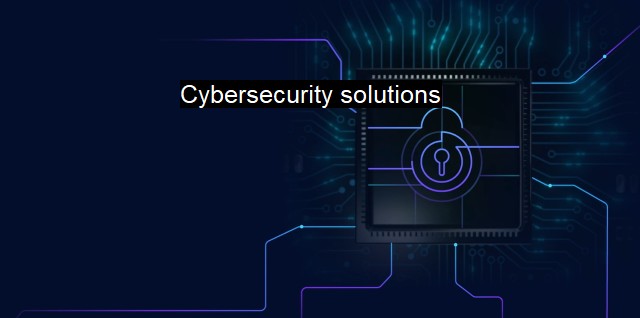What are Cybersecurity solutions?
The Importance of Cybersecurity Solutions in Modern Computing Environments: Safeguarding Businesses from Cyber-Crime and Hacking
Cybersecurity solutions refer to a collection of methodologies, processes, technologies, and systems designed to protect networks, devices, programs, and data from digital attacks, unauthorized accesses, or destruction. At its core, the purpose of these solutions is to provide a secure environment for computers, servers, networks, and other technological systems. In an increasingly digital and interconnected world, Cybersecurity solutions are becoming not just beneficial but an absolute necessity.Cybersecurity solutions greatly range in scope and sophistication, fitting for a technological threat environment that is always changing and advancing rapidly. They span across numerous areas, with some solutions focusing on network security, application security, others on data or end-point security, while some channel their resources for identity management, database and infrastructure security, or cloud security.
Network security solutions aim to protect the integrity and usability of a network and the data within it. They target threats and stop them from entering or spreading within the network. Considering the high-risk environment that is the internet, application security solutions are focused on ensuring that applications are free from threats. Regularly, these solutions involve measures such as built-in security features within applications, security testing before, during, and after the application is deployed, and regular updating and patching.
Endpoint security refers to the practice of protecting a business network when accessed by remote devices like smartphones, laptops and other wireless devices. It's the endpoint devices that serve as points of access for cyber criminals, providing an entry point that can potentially be exploited. By securing these endpoints the chance of a malicious entry or data exfiltration is significantly limited.
In the era of big data, data security is essential. Cybersecurity solutions also encapsulate the processes and practices in place to prevent unauthorized access to computers, databases or websites. Database and infrastructure protection solutions are broader in scope, concentrating on securing information stored in database management systems, as well as network infrastructure.
Cloud security is becoming increasingly important as organizations move more data and applications to cloud platforms. This solution provides protection for data used in cloud services and applications, ensuring data integrity for end users and enterprises.
Noteworthy among cybersecurity solutions is antivirus software, monitoring the system for malicious activities such as malware, ransomware, and other malicious codes that can significantly harm the system. Antivirus software tirelessly works to prevent, detect, and remove problematic codes and software.
Another critical cybersecurity solution is threat intelligence which allows organizations to understand and anticipate current and emerging threats. This involves in-depth data analysis to identify patterns of behavior that might indicate a cybersecurity threat. Once detected, preventative action can take place promptly.
These digital safeguards reflect the wide-ranging landscape of cybersecurity solutions, each optimized and developed to ensure unparalleled protection for different aspects or layers of technology. These solutions cater to everything from single user desktops, to small and medium enterprises, all the way up to multinational corporations and government institutions. Given the gravity of potential cyber threats, the cost-benefit of substantial and durable cybersecurity solutions significantly weighs in its favor.
As long as digital interfaces and technology continue to be an essential part of society, organizations and individuals will persist to be targets of cyber threats. Thus, cybersecurity solutions will indefinitely remain instrumental for good cyber health. It's clear that robust and responsive cybersecurity solutions are fundamental in ensuring the smooth, safe operation of contemporary cyberspace. cybersecurity solutions encompass various strategies, tools, and programs designed purposely to safeguard digital equipment, data, networks, programs, and users from digital attacks or unauthorized access, illustrating the substantial value in proactively securing digital environments.

Cybersecurity solutions FAQs
What is a cybersecurity solution?
A cybersecurity solution is a set of tools, technologies, and practices designed to protect computers, networks, and other digital systems from cyber threats such as viruses, malware, and hacking attacks. It involves implementing measures such as antivirus software, firewalls, and secure communication protocols.What are the benefits of using a cybersecurity solution?
Using a cybersecurity solution helps protect your organization's sensitive data and systems from cyber attacks. It can prevent unauthorized access to your network, safeguard your company's reputation, and save you from costly data breaches. Additionally, implementing cybersecurity can help your business comply with industry regulations and standards.What should I look for in a cybersecurity solution?
Look for a cybersecurity solution that is comprehensive, easy to use, and customizable to fit your organization's needs. A good cybersecurity solution should include a range of protective measures, such as antivirus software, firewalls, intrusion detection systems, and backup and recovery tools. It should also provide ongoing support and updates to ensure continued protection against evolving threats.How can I ensure that my cybersecurity solution is working effectively?
To ensure that your cybersecurity solution is working effectively, regularly monitor and test your systems for vulnerabilities and threats. Conduct regular security audits and assessments, and ensure that all security patches and updates are installed promptly. Additionally, provide cybersecurity training for your employees to help them identify and respond to potential security threats.| | A | | | B | | | C | | | D | | | E | | | F | | | G | | | H | | | I | | | J | | | K | | | L | | | M | |
| | N | | | O | | | P | | | Q | | | R | | | S | | | T | | | U | | | V | | | W | | | X | | | Y | | | Z | |
| | 1 | | | 2 | | | 3 | | | 4 | | | 7 | | | 8 | | |||||||